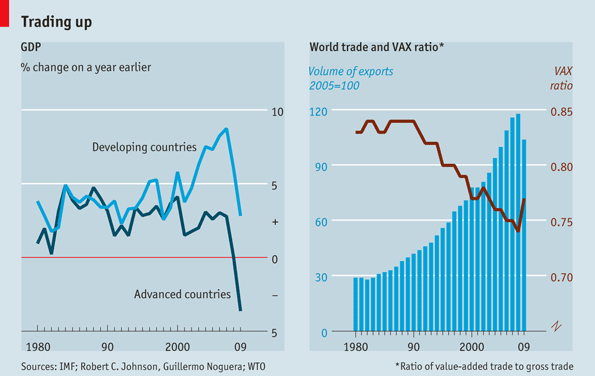

| Visitors Now: | |
| Total Visits: | |
| Total Stories: |

| Story Views | |
| Now: | |
| Last Hour: | |
| Last 24 Hours: | |
| Total: | |
Miracle Economic Growth from Global Supply Chains
From
The Economist magazine examines the question – Is the age of the growth miracle at an end?
Harvard economist Dani Rodrik, in which he argued that the age of the “growth miracle” was over. Industrialisation, long the engine of economic development, is becoming less able to support catch-up growth, he suggested, thanks to the falling labour-intensity of manufacturing, Chinese competition, and a rising mercantilist tide across the rich world.
Richard Baldwin, whose research on a supply-chain-oriented view of globalisation and development was recently featured in the print edition, strongly disagrees:
The truth is that globalization has been driven by advances in two very different types of “connective” technologies: transportation and transmission. Up till the late 1980s, globalization was mostly about lower trade and transportation costs. This “first unbundling” of production was associated with rising G7 shares of world income and trade…
Since then, globalization has mostly been about lower communications and transmission costs. This “second unbundling” of production has seen G7 shares of world income and trade fall dramatically. Globalization’s second unbundling involves two phenomena:
* Fractionalisation (unbundling of supply chains into finer stages of production); and
* Geographic dispersion of the unbundled stages.Global supply chains (GSCs) are the connective tissue that allows fractionalized and dispersed stages to operate as a harmonious whole.
GSCs transformed the world by allowing poor nations to join supply chains rather than investing decades in building up their own. This is where Rodrik’s analysis falls down. He calls these “growth miracles” because he overlooks the fundamental change in the nature of globalization that enabled them
See more and subscribe to NextBigFuture at 2012-08-16 03:21:14 Source: http://nextbigfuture.com/2012/08/miracle-economic-growth-from-global.html
Source:



